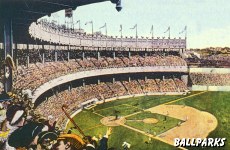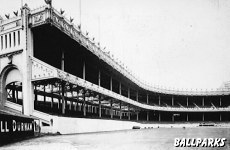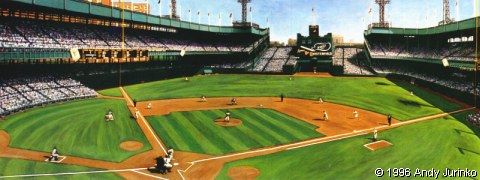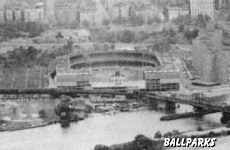

Central Park between 5th & 6th Aves. from 110th to 112th Sts. |
Coogan's Hollow between 155th and 157th Sts. |
Coogan's Hollow between 157th and 159th Sts. |
|
NYC confiscated the property |
larger field to the north when the Players League abandoned it |
Polo was played in the 1870s on a site just north of Central Park bound by 5th & 6th Avenues and 110th & 112th Streets. The site became know as the Polo Grounds. By 1883, baseball had taken over the site. The New Yorks (later called the Giants) of the National League played in the southeast corner of the park and the Metropolitans of the American Association played in the southwest corner. In 1889, when the Giants were evicted from the original Polo Grounds, they moved uptown to a stadium on the southern parcel of Coogan's Hollow. Also known as Manhattan Field, from the beginning it was called the New Polo Grounds (Polo Grounds II).


Opened: June 28, 1911
First night game: May 24, 1940
Last game: September 18, 1963
Capacity: 34,000 (1911); 55,000 (1923)
Demolished: April 10, 1964
Architects: Henry B. Herts and Osborn Engineering (1912)
Construction: n/a
Owner: New York Giants
Cost: n/a
A.K.A.: Brush Stadium (1911 to 1919), Coogan’s Bluff, Coogan’s Hollow, Matty Schwab’s house, Harlem Meadow.
Location: Center field (SE), Eighth Avenue, then IRT elevated tracks, Harlem River, and Harlem River Drive; third base (NE), West 159th Street and IRT Rail Yards; home plate (NW), Bridge Park, then Harlem River Speedway, Coogan’s Bluff, and Croton Aqueduct; first base (SW), West 157th Street trace; same site as Polo Grounds (III); in the norther half of Coogan’s Hollow, 115 feet below Coogan’s Bluff.

Dimensions: Left Field: 277 (1911), 286.67 (1921), 279.67 (1923), 279 (1930), 280 (1943), 279 (1955); Left Field, second deck: 250; Left center, left of bullpen: 447; Left center, right of bullpen: 455; Front of clubhouse steps: 460; Center field: 433 (1911), 483 (1923), 484.75 (1927), 505 (1930), 430 (1931), 480 (1934), 430 (1938), 505 (1940), 490 (1943), 505 (1944), 448 (1945), 490 (1946), 484 (1947), 505 (1949), 483 (1952), 480 (1953), 483 (1954), 480 (1955), 475 (1962), 483 (1963); Bleacher corners: 425 when center field was 475; Right center, left of bullpen: 449; Right center, right of bullpen: 440; Right field: 256.25 (1921), 257.67 (1923), 257.5 (1931), 257.67 (1942), 259 (1943), 257.67 (1944); Right field, second deck photographers' perch: 249; Backstop: 65 (1942), 70 (1943), 65 (1944), 70 (1946), 74 (1949), 65 (1954), 74 (1955), 65 (1962); Foul territory: very large.
Fences (1911-22): Left to center: 10 (concrete); center: 20 (tarp); right-center: 10 (concrete); right field: 12 sloping to 11 at pole (concrete).
Fences (1923-63): Left field: 16.81 (concrete); left-center: 18 (concrete); point where left-center wall ended at bleachers: 12 (concrete); center-field bleachers wall: 8.5 (4.25 wire on top of 4.25 concrete) on both sides of clubhouse runway; center-field hitters’ background: 16.5 on both sides of clubhouse runway; center-field clubhouse: 60 high and 60 wide—50 high in 1963; center field, top of Longines Clock: 80; center field, top of right side of scoreboard: 71; center field, top of left side of scoreboard: 68; center field, top of middle of scoreboard: 64; center field, top of five right scoreboard windows: 57; center field, top of four left scoreboard windows: 55; center field, bottom of five right scoreboard windows: 53; center field, bottom of four left scoreboard windows: 48; center field, bottom of clubhouse scoreboard: 31; center field, top of rear clubhouse wall: 28; center field, top of front clubhouse wall: 19; center field, top of 14 lower clubhouse windows: 16; center field, bottom of 14 lower clubhouse windows: 11; center field clubhouse floor overhang: 8; center field, top of Eddie Grant Memorial: 5; center field, width of little office on top of lower clubhouse: 10; right-center: 12 (concrete); right field: 10.64 (concrete).

